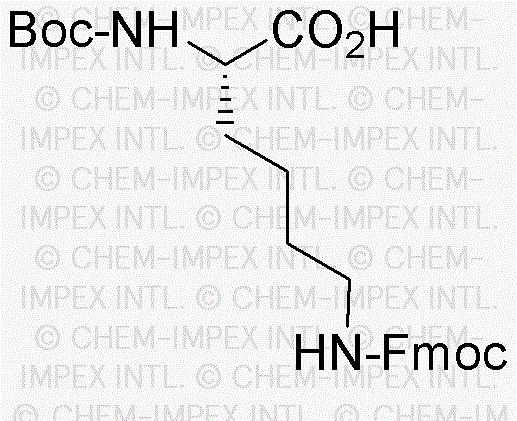Na-Boc-Ne-Fmoc-L-Lysine is widely utilized in research focused on:
- Peptide Synthesis: This compound serves as a key building block in the synthesis of peptides, allowing researchers to create complex molecules for drug development and biological studies.
- Protein Engineering: It is used in the modification of proteins, enabling scientists to enhance stability and functionality, which is crucial in biopharmaceutical applications.
- Drug Delivery Systems: The compound's unique properties facilitate the design of targeted drug delivery systems, improving the efficacy of therapeutic agents while minimizing side effects.
- Bioconjugation: It plays a significant role in bioconjugation processes, where it helps attach drugs or imaging agents to biomolecules, enhancing their therapeutic and diagnostic capabilities.
- Research in Cancer Therapy: Researchers leverage its properties to develop novel cancer therapies, as it allows for the precise modification of therapeutic agents to improve their targeting and effectiveness.
Información general
Propiedades
Seguridad y normativas
Aplicaciones
Na-Boc-Ne-Fmoc-L-Lysine is widely utilized in research focused on:
- Peptide Synthesis: This compound serves as a key building block in the synthesis of peptides, allowing researchers to create complex molecules for drug development and biological studies.
- Protein Engineering: It is used in the modification of proteins, enabling scientists to enhance stability and functionality, which is crucial in biopharmaceutical applications.
- Drug Delivery Systems: The compound's unique properties facilitate the design of targeted drug delivery systems, improving the efficacy of therapeutic agents while minimizing side effects.
- Bioconjugation: It plays a significant role in bioconjugation processes, where it helps attach drugs or imaging agents to biomolecules, enhancing their therapeutic and diagnostic capabilities.
- Research in Cancer Therapy: Researchers leverage its properties to develop novel cancer therapies, as it allows for the precise modification of therapeutic agents to improve their targeting and effectiveness.
Documentos
Hojas de datos de seguridad (HDS)
La SDS proporciona información de seguridad completa sobre la manipulación, el almacenamiento y la eliminación del producto.
Especificación del producto (PS)
La PS proporciona un desglose completo de las propiedades del producto, incluida la composición química, el estado físico, la pureza y los requisitos de almacenamiento. También detalla los rangos de calidad aceptables y las aplicaciones previstas del producto.
Certificados de análisis (COA)
Busque certificados de análisis (COA) ingresando el número de lote del producto. Los números de lote y de partida se pueden encontrar en la etiqueta de un producto después de las palabras "Lote" o "Lote".
Número de catálogo
Número de lote/lote
Certificados de origen (COO)
Este certificado de origen confirma el país en el que se fabricó el producto y también detalla los materiales y componentes utilizados en él y si se deriva de fuentes naturales, sintéticas u otras fuentes específicas. Este certificado puede ser necesario para cumplir con las normativas aduaneras, comerciales y regulatorias.
Número de catálogo
Número de lote/lote
Hojas de datos de seguridad (HDS)
La SDS proporciona información de seguridad completa sobre la manipulación, el almacenamiento y la eliminación del producto.
DownloadEspecificación del producto (PS)
La PS proporciona un desglose completo de las propiedades del producto, incluida la composición química, el estado físico, la pureza y los requisitos de almacenamiento. También detalla los rangos de calidad aceptables y las aplicaciones previstas del producto.
DownloadCertificados de análisis (COA)
Busque certificados de análisis (COA) ingresando el número de lote del producto. Los números de lote y de partida se pueden encontrar en la etiqueta de un producto después de las palabras "Lote" o "Lote".
Número de catálogo
Número de lote/lote
Certificados de origen (COO)
Este certificado de origen confirma el país en el que se fabricó el producto y también detalla los materiales y componentes utilizados en él y si se deriva de fuentes naturales, sintéticas u otras fuentes específicas. Este certificado puede ser necesario para cumplir con las normativas aduaneras, comerciales y regulatorias.


